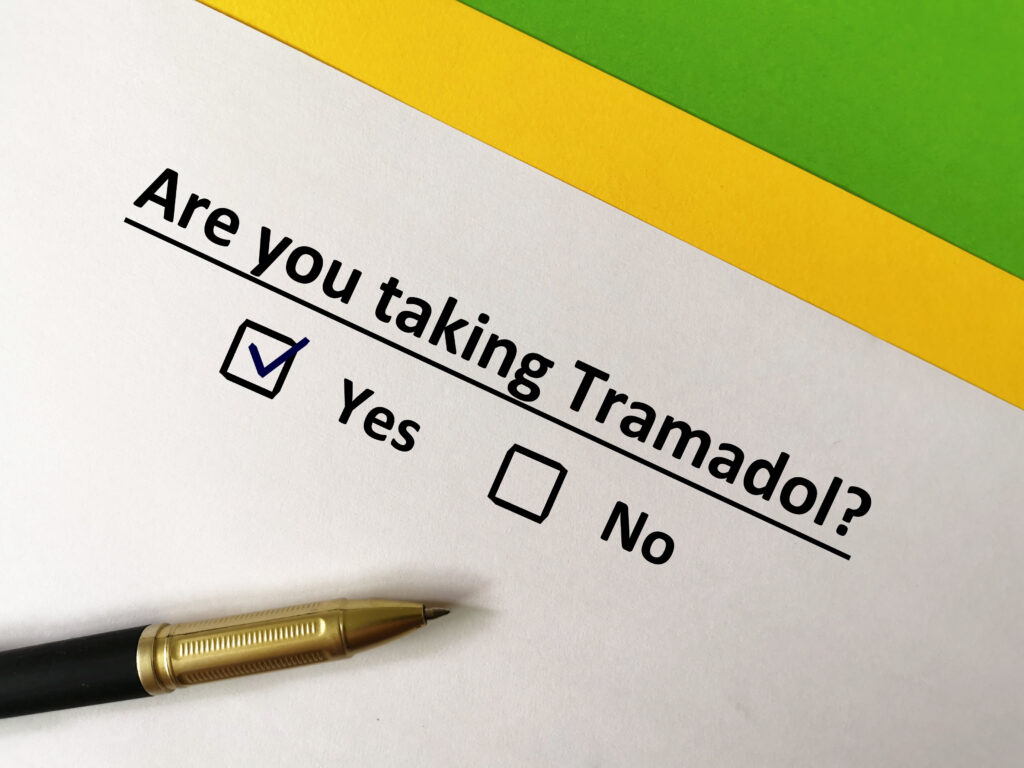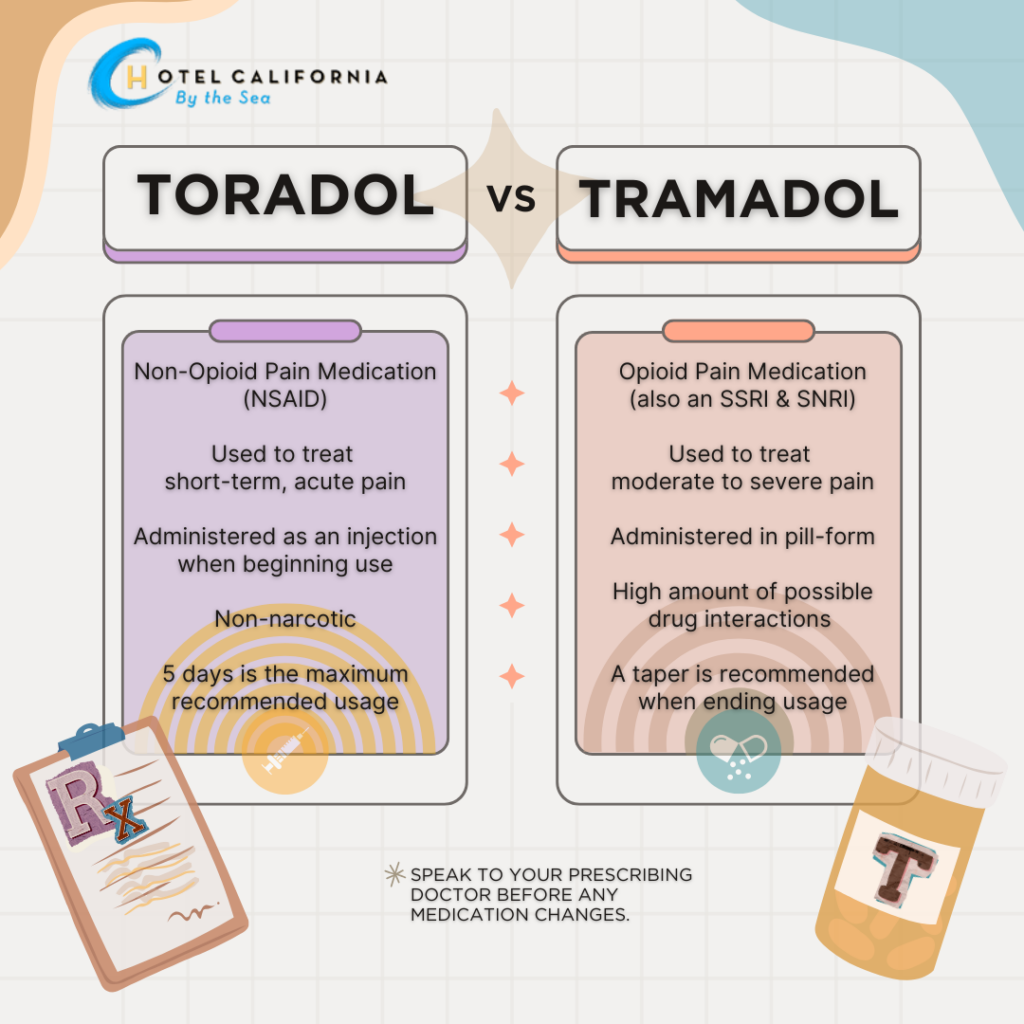Tramadol vs Toradol
Toradol and Tramadol are both prescription medications used for the treatment and management of pain. They may sound like similar types of medication, but they are in fact, very different. Toradol is a nonsteroidal anti-inflammatory drug (NSAID) that treats pain and inflammation. Think of a prescription-grade Aspirin or Ibuprofen. Tramadol is an opioid pain-relieving medication that also treats and manages pain. Both medications are only available through a prescription and both are effective medications when used per the recommendation of your medical provider. However, when abused, both medications can result in significant side effects both short-term and long-term.

Tramadol is the generic name for the brand Ultram. The prescription opioid is available in an extended-release and immediate-release formulation. Tramadol is a Schedule IV controlled substance that works by attaching to the mu-opioid receptors in the brain and changes the way the body recognizes pain. It also helps alleviate the sensation of pain by raising the levels of neurochemicals in the brain such as serotonin and norepinephrine.
Toradol is the brand name for the generic medication ketorolac. It is FDA-approved for short-term treatment of moderate to severe acute pain such as after-surgery pain control and possibly opioid level pain management. It can also be used to treat musculoskeletal pain, migraines and sickle cell-related pain. It works by blocking cyclooxygenases, which convert arachidonic acid into prostaglandins, prostacyclin and thromboxane. The inhibition of these substances helps the user feel decreased pain, fever and inflammation.
More on Tramadol
Tramadol works by changing how your brain senses pain. Tramadol is similar to brain chemicals called endorphins. Endorphins bind to receptors and receptors decrease the pain messages your body sends to and from the brain. It works by decreasing the amount of pain your body thinks you have because it isn’t getting as many signals. Because tramadol is an opioid medication with a high risk of dependence, the medication can also cause withdrawal symptoms if the user suddenly stops or drastically decreases medication intake. Withdrawal symptoms such as anxiousness, difficulty sleeping, rapid heart rate, runny nose, diarrhea and muscle aches are common. To avoid this, tapering is the most effective method when coming off tramadol.
More on Troadol
Toradol is initially injected intravenously or intramuscularly. It is then followed by oral treatments. When using Toradol, the medication must be first injected either through the veins or muscle. A typical Toradol injection intravenously is anywhere between 15mg – 30mg. A typical intramuscular injection is anywhere between 30mg – 60mg. After the initial injection, users can take the medication orally, in which a typical dose is between 10mg – 20 mg. In some studies, Toradol has been known to work just as well as morphine for treating certain types of pain. However, like other NSAID medications, it should only be used short term due to severe side effects such as cardiovascular issues and the risk of stomach ulcers. Toradol is often prescribed alongside opioids to help with pain management and reduce opioid requirements, which can ultimately reduce the adverse effects of opioids.

Tramadol vs Toradol
Tramadol
- Brand name Ultram
- Tramadol is a controlled substance and is FDA-approved for adults for the treatment of moderate to severe pain
- Tramadol is only used when non-opioid medications are not strong enough to relieve pain that cannot be tolerated
- Tramadol works by binding to opioid receptors to inhibit the reuptake of neurotransmitters that carry messages in the brain
- Tramadol is available in extended and immediate-release tablets
- Treatment should begin at the lowest effective dose and should be prescribed for the shortest amount of time possible
- Tramadol costs anywhere between $7-24
- Tramadol should be gradually tapered off in order to avoid withdrawal symptoms
- Off-label uses of tramadol include – treatment for restless leg syndrome, treatment for osteoarthritis pain, treatment for skin pain after shingles infection and treatment for nerve damage associated with diabetes
- Common side effects of tramadol include – dizziness, vertigo, nausea, vomiting, constipation, headache, sleepiness, itching, weakness, sweating, indigestion, dry mouth, seizures, abuse, withdrawal, addiction, and respiratory depression
Toradol
- Generic name ketorolac
- The brand name Toradol is no longer available in the US. The drug is only available in its generic form
- Toradol is a prescription non-steroid anti-inflammatory drug approved by the FDA for the treatment of moderate to severe pain
- It is not a narcotic or controlled substance and does not carry a risk of abuse or dependence
- Toradol works by preventing the body from producing prostaglandins. Prostaglandins are substances that cause pain and inflammation and when they are prevented from producing, they can help reduce symptoms of pain and inflammation in the body
- Toradol is initially taken as an injection and then followed by an oral tablet. The patient must have an intravenous or intramuscular injection before using the tablet
- Because of the risks of Toradol use, treatment should not last more than 5 days
- Toradol can cost anywhere from $12-26
- Off-label uses for Toradol include – the treatment of moderate to severe pain in children, treatment of pain due to cancer that has mediatized to the bones and treatment of acute migraine pain in an ER setting
- Common side effects of Toradol include – nausea, stomach pain, indigestion, headache, drowsiness, dizziness, diarrhea, GI ulcers and bleeding
Check Your Insurance Coverage for FREE
Find out if your insurance covers addiction treatment in minutes. We accept most insurance!
Dangers and risks of using Tramadol and Toradol
When misused or abused, tramadol can cause serious side effects that put the user’s health at risk. With tramadol, there is a high risk of misuse and addiction, respiratory depression, overdose, serotonin syndrome, seizures, low blood pressure, low adrenal hormone level and physical dependence and withdrawal. Slowed breathing or respiratory depression is at the highest risk within 3 days after starting tramadol or if you increase your drug dosage. It causes shallow breathing that can cause fainting dizziness or for you to stop breathing completely. Serotonin syndrome causes fast heart rate, blood pressure and high body temperature, a lack of coordination, nausea, vomiting, hallucinations and coma.
Though Toradol does not have a potential for abuse or addiction, there are serious side effects of the medication if used over a longer period of time. Risks of Toradol use include stomach bleeding, stomach ulcers, heart attack, stroke, heart failure, blood clots, high blood pressure and development or worsening of liver and kidney problems.
Reach out to Hotel California by the Sea
We specialize in treating addiction and other co-occurring disorders, such as PTSD. Our Admissions specialists are available to walk you through the best options for treating your addiction.
Treatment for Substance Use Disorder
Tramadol and Toradol are prescription medications often used to help in the treatment of moderate to severe pain. Toradol is a prescription-strength NSAID that carries the risk of severe GI issues when used for longer than prescribed. Toradol can also cause serious damage to the liver and kidneys. Though there is no risk of addiction to Toradol, there is a risk of other health issues. Tramadol is an opioid with a high risk for abuse that can lead to dependence and addiction. It is a central nervous system depressant and can result in side effects common in opioid drugs. Treatment for substance use disorders is most effective with behavioral health treatment programs such as Hotel California by the Sea.
We offer treatment at all levels of care including detox, residential, PHP and IOP. We also provide evidence-based treatment methods such as CBT, DBT and EMDR therapy. Hotel California by the Sea is dedicated to helping all our clients reach their goals of recovery and overcome their addiction.
References:
https://www.verywellhealth.com/the-differences-between-toradol-and-tramadol-7559395
https://www.goodrx.com/compare/toradol-vs-tramadol
https://www.ncbi.nlm.nih.gov/books/NBK537060
https://www.healthline.com/health/tramadol-oral-tablet
https://www.ncbi.nlm.nih.gov/books/NBK545172
https://www.singlecare.com/blog/toradol-vs-tramadol/
